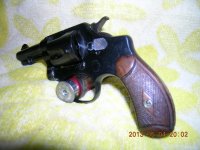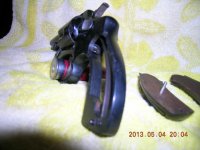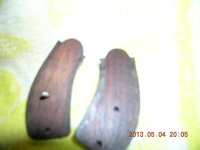TACC1
WOW, the mystery only deepens. The letter states it came with "checkered walnut extension square butt grips". That description is most used for the two screw ext 'target' stocks. Regulated Police rebated sq butt stocks with one screw are usually described as just checkered walnut square butt stocks. So I don't think the letter rules out the target stocks which would use a standard round butt configured grip frame like roughly 90% of the Bekeart 22/32 revolvers, the others having the rebated 1 screw sq buttstocks for a period in the early 1020s. And ALL
stamped w/serial # on the front grip strap.
Now I realize the 38 S&W round butt Terrier wasn't introduced until 1936. But the same basic 32 frame with round butt was used for 22, 32 and 38. So as seen on the Bekeart models and RP models supplied with the 2 screw target stocks, the rebated backstrap milling was always deleted. So I don't believe that it's inconceivable for your gun to have been originally supplied w/target stocks and not rebated!
It's obvious that a prior owner of your RP desired a shorter barrel than was available in 1922, perhaps before 1936 when the 2" became available. So why would he not substitute the smaller rd butt grips as well since they fit perfectly! They are also the correct vintage for your gun, no medallions.
I have two requests:
How far apart are the s/ns of the gun and the grips?
And I would love to see a clear close up photo of the grip frame w/o the grips.
The letter is interesting from another angle. It states that your model gun was converted to the J frame in 1956, when the I frame was dropped and the ext sq butt grips were discontinued; this is clearly in error.
The rebated grip frame ended with the introduction of the Model of 1953 New I frame (albeit many rebated sg butt guns still in inventory were shipped after 1953), and it was not built on the J frame until 1960 when the Model 33 also acquired the -1. Roy is very accomodating about correcting his letters at no additional charge when requested.
WOW, the mystery only deepens. The letter states it came with "checkered walnut extension square butt grips". That description is most used for the two screw ext 'target' stocks. Regulated Police rebated sq butt stocks with one screw are usually described as just checkered walnut square butt stocks. So I don't think the letter rules out the target stocks which would use a standard round butt configured grip frame like roughly 90% of the Bekeart 22/32 revolvers, the others having the rebated 1 screw sq buttstocks for a period in the early 1020s. And ALL
stamped w/serial # on the front grip strap.
Now I realize the 38 S&W round butt Terrier wasn't introduced until 1936. But the same basic 32 frame with round butt was used for 22, 32 and 38. So as seen on the Bekeart models and RP models supplied with the 2 screw target stocks, the rebated backstrap milling was always deleted. So I don't believe that it's inconceivable for your gun to have been originally supplied w/target stocks and not rebated!
It's obvious that a prior owner of your RP desired a shorter barrel than was available in 1922, perhaps before 1936 when the 2" became available. So why would he not substitute the smaller rd butt grips as well since they fit perfectly! They are also the correct vintage for your gun, no medallions.
I have two requests:
How far apart are the s/ns of the gun and the grips?
And I would love to see a clear close up photo of the grip frame w/o the grips.
The letter is interesting from another angle. It states that your model gun was converted to the J frame in 1956, when the I frame was dropped and the ext sq butt grips were discontinued; this is clearly in error.
The rebated grip frame ended with the introduction of the Model of 1953 New I frame (albeit many rebated sg butt guns still in inventory were shipped after 1953), and it was not built on the J frame until 1960 when the Model 33 also acquired the -1. Roy is very accomodating about correcting his letters at no additional charge when requested.









